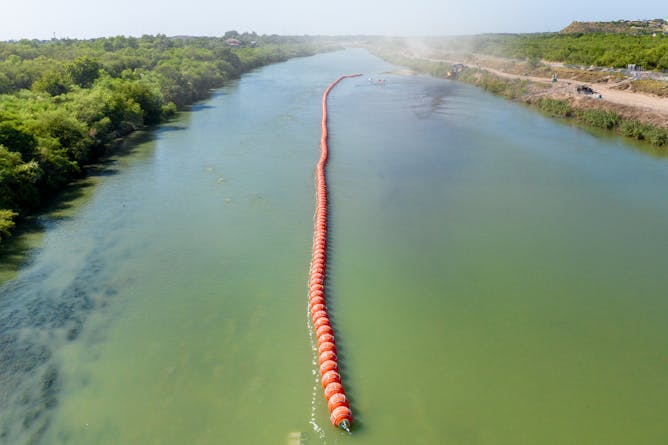|
Top headlines
Lead story
I reported on immigration in southern Arizona several years ago and still think about the desert’s unforgiving landscape. Local aid workers led me through a popular, remote path for migrants that was littered with empty plastic water jugs, worn sneakers and wooden crosses planted in the dirt, marking the memory of those who did not survive the treacherous journey through the arid mountains to the U.S.
People often embark on this journey to save their lives or the lives of their children. And so when I saw the large orange buoys that Texas officials had lined up in the Rio Grande, I instantly recognized this as an attention-grabbing measure, unlikely to actually stop migrants who desperately wanted to cross the river and enter the U.S.
I reached out to immigration law scholar Jean Lantz Reisz for more context. She explained how the move could, in fact, backfire: The orange buoys – now the subject of a lawsuit the federal government has launched against the state of Texas – could end up impeding immigration enforcement rather than help secure the borders.
[ Miss us on Sundays? Get a selection of our best and most popular stories (or try our other weekly emails). ]
|

|
Amy Lieberman
Politics + Society Editor
|
|

Buoy barriers are shown in the middle of the Rio Grande in Eagle Pass, Texas, on July 18, 2023.
Brandon Bell/Getty Images
Jean Lantz Reisz, University of Southern California
Setting up buoys in a section of the Rio Grande is more likely to result in migrants seeking pathways elsewhere, rather than deterring migration altogether.
|
Politics + Society
|
-
Lorna Grisby, The Conversation
Plea deals are common in American criminal courts. But in the federal government’s tax case against Hunter Biden, the judge refused to sign off on a deal.
-
Howard Manly, The Conversation
As a powerful branch of government, the Supreme Court has enormous power over public policy only if defendants comply with its rulings.
|
|
Ethics + Religion
|
-
Dusty Hoesly, University of California, Santa Barbara
A professor who has researched the Universal Life Church unpacks why many couples now prefer to hand-pick loved ones to perform their ceremonies.
|
|
Arts + Culture
|
-
Katelyn Best, West Virginia University
Dip hop artists move across the stage, hands flying through the air, as audiences pulse to the rhythm of a blasting bass beat.
|
|
Economy + Business
|
-
Steven Gerencser, Indiana University
Progressives have cheered Disney in its battle with Florida Gov. Ron DeSantis over LGBTQ rights. But joining forces with corporations poses risks when principles no longer align with profits.
-
Brian L. Connelly, Auburn University; Lori Trudell, Clemson University
A new study finds that investors punish companies for behaving badly over three times as much if they have a record of saying they’re virtuous.
|
|
Education
|
-
Nicholas De Dominic, USC Dornsife College of Letters, Arts and Sciences
Only 218 programs offer credit-bearing college programs in prison. That’s about to change.
|
|
Science + Technology
|
-
Subhash Kak, Oklahoma State University
Many of the amino acids that make up proteins are encoded by genetic material in more than one way. An information theorist explains how principles of nature may account for this variance.
|
|
Environment + Energy
|
-
Michael Wysession, Arts & Sciences at Washington University in St. Louis
The bad news: This extreme heat is probably going to stick around for a couple more years.
|
|
|
|
|
|
|
|
| |
| |
| |
| |
|
|